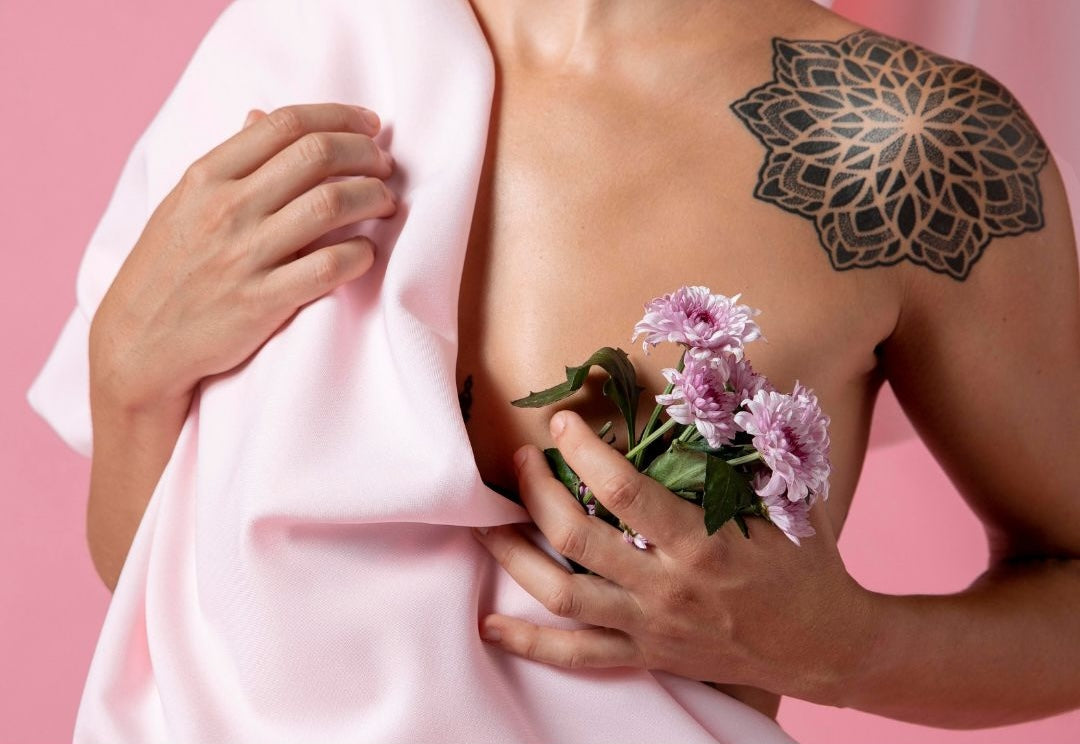If you’re recovering from breast cancer—or you love someone who is—this guide is for you. Bodies and confidence can shift after surgery, radiation, or medication. You might be navigating scars, new sensations, fatigue, dryness, or simply a relationship with your chest that feels different now. That isn’t failure; it’s a new map. Our aim is to help you (and/or your partner) feel sexy and safe today, with practical ways to rebuild comfort, closeness, and confidence at your pace.
Why sexual wellness belongs in Pink October
Breast cancer touches body image, sensation and relationship dynamics, so intimacy naturally evolves. A compassionate guide can help readers feel seen and offer simple, practical ways to stay connected (solo or with a partner) during treatment and recovery—without medical jargon.
What may change (totally normal)
-
Body image: scars, swelling or asymmetry may feel confronting.
-
Sensation: chest/nipple sensitivity can be lower, higher or simply different.
-
Energy & mood: fatigue and brain fog can reduce desire; anxiety can dampen arousal.
-
Vaginal dryness or discomfort: some medications and stress can contribute.
Will sensitivity or libido change?
Short answer: it can, and it often does—temporarily or long‑term—and that’s normal.
-
Sensitivity: Surgery and radiation can alter nerve pathways around the chest; some people feel less or different sensation, some feel more sensitivity in certain areas. Sensation can evolve over months. You never have to include chest touch; treat it as opt‑in and explore other hotspots while your body finds its new baseline.
-
Libido/desire: Fatigue, stress, pain, and some medications (including certain hormonal treatments) can lower desire or delay arousal. That doesn’t mean intimacy is over; it means your warm‑up and pacing change. Think shorter sessions, more build‑up, and less pressure to “perform.”
-
What helps now:
-
Plan for comfort: soft lighting, supportive pillows, and a slower warm‑up.
-
Use lube early: water‑based for most play; silicone/hybrid for glass/metal toys.
-
Try new routes: neck, shoulders, back, hips, thighs; low‑intensity wands on large muscles (not on healing areas).
-
Try temperature play: warmed (not hot) massage stone or a cooled glass/steel toy; test on your forearm first and avoid healing/irradiated areas.
-
Talk to your care team about persistent pain, dryness, or medication side effects; small clinical tweaks can make a big difference.
-
Body comfort first (skin, scars, fit)
For survivors, comfort is the springboard to feeling sexy again. Start with textures, fits, and lighting that make you feel at home in your body, then add touch slowly on your terms. Choose soft fabrics, seam‑light bralettes, and non‑fragranced body care. If the chest area is tender, try front‑closure or wireless pieces and shift touch to comfortable zones (arms, back, thighs). Keep contact light and slow.
For survivors, comfort is the springboard to feeling sexy again. Start with textures, fits, and lighting that make you feel at home in your body, then add touch slowly on your terms. Choose soft fabrics, seam‑light bralettes, and non‑fragranced body care. If the chest area is tender, try front‑closure or wireless pieces and shift touch to comfortable zones (arms, back, thighs). Keep contact light and slow.
If you’ve had a single or double mastectomy (for survivors)
-
You are allowed to define “sexy.” Confidence can look like a favourite tee, a one‑shoulder bra, or nothing at all.
-
Wardrobe that supports you now: bralettes with pockets for forms, asymmetrical/one‑cup styles, soft camisoles, or a robe that makes you feel gorgeous. If symmetry feels affirming, try light silicone forms or soft fabric inserts; if not, skip them.
-
Skin comfort: moisturise healed areas with unscented lotion; avoid any pull on healing or irradiated skin. When in doubt, keep touch around the chest hands‑off and focus on other hotspots.
-
Confidence ritual (2 minutes): breathe, name three things you like about your body today, pick one garment or accessory that makes you feel powerful.
Moisture & comfort (simple, non‑clinical)
For dryness, start with water‑based lubricant (toy‑safe, linen‑friendly). Silicone‑based or hybrid formulas can add longer glide for external massage or with glass/steel toys; avoid silicone lube on silicone toys. For day‑to‑day comfort, readers can ask a clinician about non‑hormonal vaginal moisturisers.
Partners: what to say
“I love you and your body as it is today. What would feel good—massage, cuddling, a short play session, or just being close?”
How to help your partner rebuild confidence
-
Mirror their pace. Let them choose clothing, lighting, and whether the chest is touched—or not.
-
Praise specifics. Compliment what you see and feel right now (collarbones, back, laugh, courage), not the “before.”
-
Hands that listen. Start on agreed‑safe zones (shoulders, back, hips, thighs). Ask “slower/softer/here?” and follow.
-
Pre‑intimacy checklist (1 minute): water, tissues/wipes, lube, soft lighting, safe‑word/stop‑signal agreed.
If chest/nipple touch is complicated:
-
Treat the chest as opt‑in only. Use a silk scarf or soft tee as a fabric “buffer” over the area if visual exposure is hard but closeness feels good.
-
Redirect arousal to a touch map you both agree on (neck, jawline, scalp, upper back, sacrum, inner thighs, behind knees, feet).
Safety notes (without getting clinical)
Avoid strong stimulation on healing scars or irradiated skin, skip anything that pulls on drains/sensitive areas, and stop if there’s pain, swelling or persistent discomfort—that’s a sign to check in with a clinician. This is wellness guidance, not medical advice.
Build a comfort‑first Pink October kit—soft bralette, water‑based lube, gentle massage oil, and a low‑intensity wand for shoulders and hips. Explore at your own pace.

